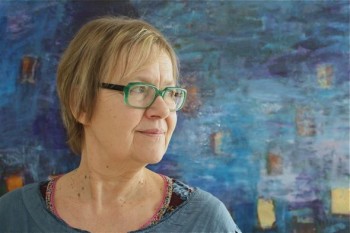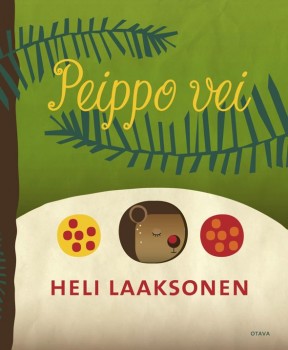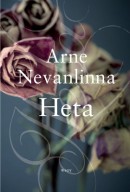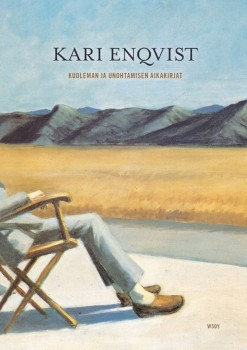Search results for "jarkko laine prize"
New from the archives
19 February 2015 | This 'n' that

Tua Forsström. Photo: Mao Lindholm
Some weeks the digitisation project turns up material we’ve all but forgotten about; other times it’s like greeting an old friend. The poet Tua Forsström’s voice belongs in the second category: quintessentially feminine, wise, simultaneously vulnerable and strong, she is a quiet, watchful observer of everyday life, fixing the chimerical, the evanescent not with, it seems, but between, the words of her poems. This extensive selection of poems is introduced by her friend and fellow poet, Claes Andersson.
Born in Porvoo in 1947, Forsström publishes rarely. She won the Nordic Council Literary Prize in 1998 with Efter att ha tillbringat en natt bland häster (‘After having spent a night with horses’, 1997). Her breakthrough into the English-speaking world came in 1987 with her sixth collection, Snow Leopard (Snöleopard), which was translated into the English by David McDuff and published by Bloodaxe Books. We’ve featured her work regularly, including her most recent collection, En kväll i oktober rodde jag ut på sjön (‘One evening in October I rode out on the lake’, Söderströms, 2012), with an introduction by Michel Ekström.
*
The digitisation of Books from Finland continues apace, with a total of 358 articles and book extracts made available online so far. Each week, we bring a newly digitised text to your attention.
Funny stuff favoured
13 April 2011 | In the news
 In March the Bookseller’s Association of Finland’s list of the best-selling Finnish fiction was topped – for a change – by a collection of poems. Like all her collections, Heli Laaksonen’s Peippo vei (‘The chaffinch took it’, Otava) is written in a local dialect spoken in south-western Finland.
In March the Bookseller’s Association of Finland’s list of the best-selling Finnish fiction was topped – for a change – by a collection of poems. Like all her collections, Heli Laaksonen’s Peippo vei (‘The chaffinch took it’, Otava) is written in a local dialect spoken in south-western Finland.
Perttti Jarla’s latest comics book, Fingerpori 4 (‘Fingerborg 4’, Arktinen Banaani) was number two – and, demonstrating the Finns’ love of cartoons and comics, another of his titles, Fingerpori book, Fingerpori – Kamppailuni (‘Fingerborg – My fight’) occupied fourth place, following Sofi Oksanen’s Puhdistus (Purge), published in 2008 and still number three on the list. More…
Jörn Donner: Mammuten [The mammoth]
14 February 2013 | Mini reviews, Reviews
 Mammuten. Efterlämnade handlingar
Mammuten. Efterlämnade handlingar
[The mammoth. Leftover business]
Helsinki: Schildts & Söderströms, 2013. 1,128 p., ill.
ISBN 978-951-152-311-54
€37.90, hardback
Finnish translation:
Mammutti. Jälkeenjääneet tekoset
Helsinki: Otava, 2013. 1,087 p., ill.
Suom. [Translated by] Kari Koski
ISBN 978-951-126-311-1
€69,90, hardback
Born in 1933 to a Swedish-speaking family in Helsinki, Jörn Donner, a prominent figure in Finland and Sweden for decades, has published some sixty books. His novel Far och son (‘Father and son’) won him the Finlandia Prize for Fiction in 1985. He has directed and produced films; as a producer he received an Academy Award for Ingmar Bergman’s film Fanny and Alexander. Donner has served two terms in the Finnish Parliament and one in the European Parliament, and represented or supported five different political parties, from the Moscow-loyal Left to the right-wing National Coalition party. Donner’s life has often been the subject of television programmes and he has never passed up the opportunity for more or less well-considered provocations. When he publishes his autobiography at the age of eighty, expectations are high, but Mammuten does not live up to them. It is a sloppy collage of old newspaper articles and introverted diary entries; what emerges is the picture of a man who is disappointed in almost everything he has achieved in life and who sees most of his human relationships as failures. Strangely enough, of the principles that have guided his restless activity and the goals he has striven for in the longer term, Donner writes almost nothing.
Translated by David McDuff
Arne Nevanlinna: Heta
14 March 2014 | Mini reviews, Reviews
 Heta
Heta
Helsinki: WSOY, 2014. 276 pp.
ISBN 978-951-0-40174-3
€34, hardback
The architect and writer Arne Nevanlinna (born 1925) published his first novel, Marie,in 2008; it became one of the six finalists for the Finlandia Prize of Fiction. His fourth novel, Heta, is set in Helsinki in the late 20th century. It depicts the Swedish-speaking Celerius family: Gustava’s seven children – three have died – and their spouses come to celebrate her 70th birthday. Noblesse oblige – the general’s widow is not wealthy, but Gustava has to keep up appearances, so she has four servants. One of them is the bright orphan girl Heta, too often called Clubfoot, because her left leg is shorter than the right, and who, to her surprise, finds out she can read people’s minds. When Gustava dies unexpectedly, poor Heta becomes a murder suspect. The plot takes surprising turns, and the epilogue, in which Heta herself is the narrator, presents the reader with even more revelations; love, it turns out, does conquer all. Nevanlinna’s depictions of the milieu and the era are colourful, and his narrative is laced with plenty of satirical comedy.
In the detail?
11 December 2009 | Essays, Non-fiction
 Extracts from Kuoleman ja unohtamisen aikakirjat (‘Chronicles of death and oblivion’, WSOY, 2009)
Extracts from Kuoleman ja unohtamisen aikakirjat (‘Chronicles of death and oblivion’, WSOY, 2009)
What’s the meaning of life? There are those who seek it in religion, while for others that is the last place to look. The scientist Kari Enqvist ponders why some people, including himself, seem physiologically immune to the lure of faith. Perhaps, he suggests, we should look for significance not in the big picture, but in the marvel of the fleeting moment
As a young boy I must have held religious beliefs. However, I cannot pinpoint exactly when they disappeared. At some point I eventually stopped saying my evening prayers, but I am unable to remember why or when this happened. ‘I was born in a time when the majority of young people had lost faith in God, for the same reason their elders had had it – without knowing why,’ writes the Portuguese poet Fernando Pessoa in The Book of Disquiet. More…
What Finland read in February
19 March 2010 | In the news
We read comics. Numbers one, six and seven on the February list of Finnish best-selling books (of the Booksellers’ Association of Finland) were comics by Pertti Jarla.
Jarla’s series about the weird town of Fingerpori with its weird citizens seems to have hit the book-buying crowds. Milla Paloniemi’s foul-mouthed hedgehog appeared as number 4.
Number two in February was the victorious latest novel by Kari Hotakainen, Ihmisen osa (‘The human lot’, Siltala, 2009), soon to be published in no less than eight languages – including English, in 2012, by Christopher Maclehose Press (UK).
Number three was a first novel by Elina Tiilikka, Punainen mekko (‘The red dress’, Gummerus), the sad story of a young woman choosing to sell sex. Tiilikka has indicated that the novel is autobiographical, which will sell copies.
Last year’s Finlandia Prize-winning novel Uuni (‘The stove’) by the veteran author Antti Hyry was still at eighth place.
Ville Kivimäki: Murtuneet mielet. Taistelu suomalaissotilaiden hermoista 1939–1945 [Broken minds. The battle for the nerves of the Finnish soldiers 1939–1945]
28 November 2013 | Mini reviews, Reviews
 Murtuneet mielet. Taistelu suomalaissotilaiden hermoista 1939–1945
Murtuneet mielet. Taistelu suomalaissotilaiden hermoista 1939–1945
[Broken minds. The battle for the nerves of the Finnish soldiers 1939–1945]
Helsinki: WSOY, 2013. 475 pp., ill.
ISBN 978-951-0-37466-5
€37, paperback
Ville Kivimäki bases this work on his dissertation. His research concentrates on how mentally wounded soldiers of the Winter War and the Continuation war (1939–1945), were treated and what sort of conclusions can be made as regards to their age and social background. Eighteen thousand men received, or were forced to undergo, psychiatric treatment; no doubt the number of those who remained untreated and those who suffered symptoms after the war was large. Cases increased not just during combat but also during the long periods of trench warfare. Mental problems were considered shameful, and often even the psychiatrists had moralising attitudes. Those who became ill were regarded as physically and mentally weaker material, trying to benefit from their illness. Treatment relied on German methods, mainly appropriate, even though unappropriate examples exist. The goal was to return the patient to the front, to useful work or home. Kivimäki also takes a look at those who did not fall sick and describes the community of the soldiers at the front and their ways of coping. Remains of wartime attitudes were, surprisingly, seen in doctor’s views as late as the 1990s, when remunerations were discussed. The book won the Finlandia Prize for Non-fiction in 2013.
Helsinki Book Fair 2012
25 October 2012 | In the news
 The twelfth Helsinki Book Fair opens today at the Exhibition and Convention Centre. Last year the Fair attracted more than 80,000 visitors.
The twelfth Helsinki Book Fair opens today at the Exhibition and Convention Centre. Last year the Fair attracted more than 80,000 visitors.
During four days around 700 interviews and discussions with writers will take place on twelve stages, and there will be more than 300 exhibitors in the various fields of literature.
Author Jari Tervo has been nominated the Book Fair Club’s columnist: in his first contribution, entitled ‘Median myllyt’ (‘The mills of the media’) Tervo says, among other things:
‘During the last 30 years the amount of public attention directed at Finnish authors has probably multiplied by ten. How has it affected the sales of literature? Not at all. The sales haven’t multiplied by ten, or even doubled. Has the increased public attention affected the content of literature? I don’t think it has….
‘The media doesn’t churn authors in its mill because literature is so exceedingly important. To the media the authors are a biomass that is able to articulate a touch more juicily than the average celebrity. An author needs less editing. It’s as simple as that.’
This time the featured country is Hungary: the guest writers are György Spiró, Sandor Zsigmond Papp, Vilmos Csaplár, Péter Esterházy and Léda Forgó. There are 30 guests from 11 countries.
The prize Rakkaudesta kirjaan, ‘Out of love for the book’, was awarded posthumously to the writer, critic and editor Jarmo Papinniemi (1968–2012), who, according to the jury of literary experts was an exceptionally versatile professional working in the field of the arts.




